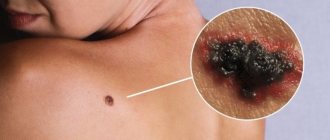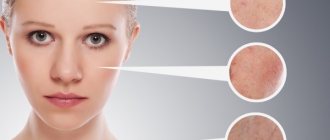The color of a mole directly depends on the processes of skin pigmentation. In this regard, sometimes nevi become more saturated in color, and this is normal. But the appearance of a black mole may indicate health problems and require immediate medical intervention. There is always a risk of it degenerating into melanoma. Experts insist on regular examination of the body for new black moles.
Typically, moles, including black ones, are present on the human body from birth or appear before the child reaches 16 years of age. At this age, the appearance of nevi of such a dark color is not considered a pathology. But if the mole formed at a later period and is increasing, then you may need to see a doctor. Read more about the formation of nevi in the article about the reasons for the appearance of moles on the body.
What is a nevus?
A mole is a consequence of the excessive work of melanocytes (cells that produce melanin), the accumulation of the pigment they produce. The more melanin spots in the cells, the darker the nevus will be. A person can have these marks from birth. Sometimes they appear throughout life - mostly before the age of 16.
The mole has darkened. Don't be scared right away. This is a normal process if it is associated with the development of a formation - a newly appeared mole. It is “born” as a light spot, which darkens over time, approaching its permanent shade. However, we note that the period of development is always gradual and consistent.
Why are black moles dangerous?
By and large, the same as ordinary, any other moles that begin to change over time. That is, there is a danger of skin cancer. To prevent such a disease, it is necessary to constantly examine the skin, spend 15 minutes several times a month and pay attention to those neoplasms that alert you. There are changes, and even sudden ones - see a doctor immediately!!! You shouldn’t delay dealing with such situations, as it is dangerous not only for health, but also for life in general.
So, why are black moles dangerous or the fact that moles turn black over time? As the body matures, not only does the number of moles on a person’s skin increase, but their shape and color also change. If this happens consistently, with slow changes, then the situation is more or less stable, but if the mole changes color sharply, and even grows at the same time, the process may be a sign of melanoma, and a trip to at least a dermatologist is definitely guaranteed.
It happens that black moles do not appear right away - it all starts with slight darkening, small black spots and dots, but this is already a sign that something is going wrong in the body or only in the formation itself. In fact, black moles themselves are not a direct sign of the degeneration of a skin formation into a malignant one, but several parameters of change, for example, the shape, size or symmetry of the mole, in combination with its blackness, are already an obvious danger.
You should not delay going to the doctor if the mole has changed, and even so obviously. It is urgently necessary to visit a specialist who will conduct research and make a diagnosis.
Signs of a safe mole
The nevi themselves are safe for the life and health of the owner of the mark. Signs of a normal mole:
- No more than 6 mm in diameter.
- Static in size - does not grow.
- Has smooth (not sharp) edges.
- Smooth surface.
- There are no roughness or growths.
- Static in color.
If black dots appear inside the nevus, which increase in size and go beyond its boundaries, then this may be one of the signs of melanoma. What is this? A malignant formation of the skin, which can lead to serious consequences for human health, like any cancerous tumor. The transformation of a harmless nevus into melanoma is called malignancy. A number of factors can provoke this.
Thus, if a mole has darkened, then this is a reason to pay attention to the nevus. But this will not be a defining sign of the development of melanoma.
Associated symptoms
Convex, hanging growths are equally susceptible to degeneration; hanging ones are often injured. The process of rebirth is accompanied by symptoms:
- Severe itching appears in the center of the mole and the area around it. Itches due to degeneration, due to the influence of external factors: insect bites, irritation from chemicals, food. When injured, the nevus can become inflamed and bleed.
- The hanging mole turns black, the old papilloma dries out and falls off. Dry old growths fall off on their own, leaving a pink mark, and a lump or new formation may appear. They dry out due to poor circulation and poor nutrition. The fallen piece should be taken for analysis to identify malignancy.
- It begins to peel off and become covered with a crust that can peel off.
- The flat growth begins to grow, change shape and structure.
- Pain appears.
- The growth or birthmark becomes hard to the touch.
- An inflammatory process accompanied by the appearance of small ulcers that emit an unpleasant odor and heal poorly.
- The skin around the formation swells, darkens or lightens, and redness appears.
Symptoms cause the development of a cancerous tumor.
Why did the mole darken?
Changes in nevi lie in the action of certain factors on them. Can a mole darken? Yes, and it’s all about the reasons that affect the activity of melanocytes (and, accordingly, the amount of pigment they produce). This is the following:
- UV rays. Ultraviolet light most contributes to the accumulation of melanin in cells. That's why we get a chocolate tan under the rays of the sun and solarium lamps. If you periodically spend a long time in the sun, you may notice that the mole has darkened along with the skin (sometimes the nevus becomes almost black, black spots appear on it). Experts advise protecting marks from direct exposure to UV rays - using protective equipment, covering yourself with clothes, and not sunbathing in the sun from 11 a.m. to 4 p.m. If you have a lot of moles on your body, then it is better to avoid going to the solarium.
- Changes in hormonal levels. This condition also affects the production of melanin. Therefore, nevi can darken during adolescence, pregnancy and menopause in women. The darkening of nevi is one of the external signals that the body is being rebuilt and there is an imbalance in its systems.
- Damage. A mole may well change its color due to mechanical impact on it or injury. The cause could even be constant friction against clothing.
Possible causes of a blackened mole
Blackening of a mole may not always be a signal of cancer. First of all, the following factors can influence the change in their color:
- Hormonal disruptions and changes in the body, this can be female menopause, pregnancy, adolescence, thyroid disease.
- Mechanical injuries of both flat and hanging nevi.
- Exposure to ultraviolet radiation, with prolonged exposure to the sun or in a solarium, can provoke an increase in the amount of melanin, as a result, black spots may appear on the mole.
Those who naturally have a lot of birthmarks, and even more so if they are dark, need to carefully protect them from the sun, because they can become even darker. To prevent such growths on the body from changing color, you need to follow several rules for staying in the sun:
- Sunbathe only in the morning and evening, when the sun is not so harmful and active.
- Do not cover moles with adhesive tape, especially in the summer; doctors are categorically against this, since a greenhouse effect is created, this can cause darkening and even infection in the body, because with a lack of oxygen, small ulcers appear.
- Don't get carried away with the solarium.
- Rest according to your skin type, for example, for fair-skinned people with numerous birthmarks, it is better to replace the sea coast with a more wooded area.
If pigment spots turn black with age and this process is almost invisible, then you don’t have to worry too much. But suddenly, in a fairly short period of time, the nevus became black, and also changed its shape and size, this may indicate its degeneration and you should urgently consult a doctor.
What is a hanging nevus?
Let’s look separately at why the hanging mole has darkened. This is an ordinary harmless nevus, but located not in the thickness of the skin, but on the so-called stalk - attached to the epithelium with a small thin piece of tissue. A number of experts note that such moles are less likely than others to degenerate into dangerous melanoma. They are distinguished by their flesh color, somewhat rough surface and small size.
These formations cause discomfort to their owner because they are more susceptible to mechanical damage from clothing, hygiene items, jewelry, etc. than other nevi. Basically, they are located in “traumatic” locations - in the armpits, on the neck, in the intimate area.
How moles are removed
Surgical intervention
Surgical excision of the mole with a scalpel is used under local anesthesia for adults and general anesthesia for small children to reduce psycho-emotional stress.
Now they have stopped removing large birthmarks in parts, since there is a risk of their rapid degeneration into melanomas.
Scars remain after the operation, so this method is not suitable for removing nevi on the face or neck.
In addition, the nevoid formation is removed, retreating 3-5 cm from it towards healthy areas of the skin.
Electrocoagulation
Removal of moles using electrocoagulation. This method is used for blackening of the mole and other signs of a malignant nature.
As a preventative measure, the method is used to remove moles in areas of friction with clothing.
High temperatures are advantageous before surgery, since simultaneously with the removal of the mole, bleeding vessels are coagulated and bleeding does not occur.
There is also no need to excise large amounts of healthy skin. The disadvantage of this method is the impossibility of removing large moles.
Cryodestruction
Cryodestruction of moles. It is prescribed in case of new sensations regarding the localization of the body of the mole and obvious external signs, for example, a change in color.
The mole is frozen at low temperatures, it dies and becomes crusty. Then the scab falls off and healthy tissue replaces it.
There is no particular pain or scarring; there is no need to excise healthy tissue along the entire border.
Cryodestruction is prescribed for small moles located at the level of the skin.
It is impossible to completely remove the age spot using this method, so it may re-develop.
In addition, healthy tissue can also be damaged by low temperatures. These are significant disadvantages of cryodestruction.
Laser therapy
Mole removal with laser. It is most often prescribed to remove a small nevus on the face or neck and other open places.
There are no pain, burns or scars, and there are no other complications.
But the method has disadvantages: a white trace remains after the laser and in hard-to-reach places it is impossible to completely remove the formation, which can lead to its re-growth.
Radiosurgical method
Moles are removed with a radio knife, which generates radioactive rays into a beam and is directed directly to the mole.
An accurate hit prevents damage to healthy tissue.
The disadvantage of the method is the lack of special equipment in the clinic or beauty salon and the impossibility of removing large pigment spots.
When removing a nevoid formation, the skin is dissected and the mole is removed.
At the site of exposure to radioactive rays, a small burn is formed that does not leave a scar or scar.
There is no bleeding, as with electrocoagulation, and the lesion is disinfected. Once removed, the crust dries out and falls off. You cannot rip it off yourself.
If there are clinical as well as external symptoms of a mole degenerating into a malignant tumor, and if it hurts, a surgical method is used and it is removed along with a small amount of healthy tissue.
This will protect the patient from further development of the tumor.
The hanging nevus has darkened - what's the matter?
If a hanging mole has darkened, then the reasons for the change lie in the following:
- Again, excessive exposure of the owner to UV rays.
- Restructuring of hormonal levels.
- Mechanical injury. The most common reason. As a result of injury, a hanging mole can not only darken, but also become inflamed, begin to dry out, and even fall off.
- Another reason for the blackening of such a nevus is a violation of the blood supply to its tissues.
How dangerous is damage to a hanging nevus? Even if the pedunculated area darkens and comes off, the base of the mole still remains deep in the layers of the skin. Damage can cause the proliferation of nevus cells in the thickness of the epithelium. This process can only be stopped surgically - by removing them.
What to look for
Everyone who is at risk needs to constantly monitor moles on the body, keep a diary and describe the condition of each nevus in it, or better yet, take photographs and compare the development of the formation from the pictures. A melanoma-dangerous mole turns black in a short period of time, becomes crusty, the skin around it becomes inflamed, a burning sensation or mild itching appears, the boundaries blur, and take on an irregular shape. Darkened areas of skin appear around the primary mole. If such changes are detected, you should immediately contact a dermatologist.
Melanoma-dangerous moles (pink hanging nevi) change their color in most cases due to mechanical damage. If the formation is torn, it may turn black (cells deprived of nutrition die). This is not a sign of degeneration, but you still need to see a doctor: the roots of the mole remain inside the skin, nevus cells spread throughout the body, so new hanging moles may appear on the body. If you see a doctor and remove the remaining base, the skin will remain clear.
Dangerous symptoms of degeneration into melanoma
First of all, we note that blackening of the nevus is in itself an alarming symptom! Yes, sometimes the reason can be banal and harmless - friction on clothes, frequent exposure to the scorching rays of the sun. But this is still a sufficient reason to contact a specialist - a dermatologist or oncologist. This way you can stop the development of melanoma in time. Or reassure yourself that everything is fine with your health.
The mole has enlarged and darkened. What could this mean? If the blackening of the nevus is accompanied by other unclear symptoms, this is a reason to urgently consult a doctor! Let's present a list of the most common signs of malignancy:
- A sharp increase in size of the formation, a change in its shape and shade.
- Liquid, blood, and mucus are often released from the nevus.
- Hairs have appeared on the mole (if they did not grow there before).
- The nevus was surrounded by a white halo of discolored skin.
- Red, black, or other different colored spots appear on the mole.
- The surface of the nevus became rough, covered with roughness and cracks.
- The skin both at the site of the mark itself and around it has become denser.
- You feel unpleasant sensations in the location of the nevus - itching, pain.
If a mole has darkened or become convex, do not hesitate, consult an experienced doctor as soon as possible! Even one of the above symptoms is a sufficient reason for a visit.
Question answer
The section, which has already become a classic, will today provide answers to some rather complex questions. We specially collected the most necessary ones, talked with experts and conveyed their opinions in text mode.
What to do if a mole turns black?
You should sound the alarm only if the mole turns black very quickly, in the shortest possible time and, in addition, causes some inconvenience. Then, you should contact an oncodermatologist, who will decide the fate of the tumor after examination and tests.
The hanging mole has turned black
Most likely, the reasons are the same as we described earlier, but a mechanical injury could also lead to a rapid change in the color of a hanging mole, for example, the mole simply got torn. But, even if the mole turns black and falls off, this is not a reason to calm down, since a malignant nevus is not only what is on the outside, the pathology can be both inside and deep inside. Symptoms of oncology are not always so obvious, and therefore, if you already had one (even though it disappeared), you have many reasons to see a doctor. It doesn’t matter where on the body this happened, even if the hanging mole under the armpit turns black, even if it falls off over time, there’s no point in pulling, remember!!!
Is it possible to cover up black moles for the summer?
There is an interesting opinion that dangerous moles need to be covered with a band-aid so that they no longer consume ultraviolet radiation on sunny days. Well, maybe that’s true (although we don’t recommend this), but sticking a mole, especially a black mole, leads to a greenhouse effect, when the neoplasm under the patch softens and can pick up any infection from the air or even from your own sweat. It also happens that a black mole, which was safe, received a portion of infection under the patch, became covered with erosions, and had to be removed, but for completely different reasons.
What to do if a mole turns black and hurts?
If one symptom is not yet an indicator of danger, then two is already too bright an indicator, and therefore, if a mole has turned black and hurts, a mole has turned black and changed in size, a mole has turned black and itches (any two symptoms of degeneration of a mole at once), then you should immediately go to the doctor.
As you can see, black moles can be dangerous and not very dangerous , but you shouldn’t tempt fate in this case, because a couple of hours of waiting in line and seeing a doctor is nothing compared to the terrible risk of melanoma.
What to do if a mole has darkened?
Let us remind you once again that the first thing you need to do is contact a medical clinic, a qualified specialist. But darkening of a mole in itself is not a sufficient reason for making a diagnosis.
The patient will be asked to undergo several diagnostic procedures. First, a visual inspection by a specialist. Then - testing (skiascopy, dermatoscopy). If the clinical picture is controversial, then an additional biopsy is prescribed.
What is the treatment?
Subsequent therapy is based on the diagnosis revealed by the results of examinations:
- Degeneration of nevus into melanoma. In this case, a traditional operation is performed under local anesthesia to remove the formation. After this, the tumor tissues are sent for histological analysis to assess their malignancy. The disadvantage of this method is that it does not prevent recurrence of such cases. But still, today this is the surest way to get rid of malignant tumors.
- Nevus does not pose a health hazard. The patient will be offered recommendations to prevent moles from degenerating into melanomas. A harmless darkened nevus can be removed using a number of hardware methods - cryodestruction (exposure to liquid nitrogen), radioknife (removal using high-frequency electromagnetic waves), electrodestruction (removal of a nevus using electric current), laser therapy methods.
Removal methods
You can remove a tumor in different ways. The choice depends on the size of the nevus and location.
- Surgical intervention . The method is used for the malignant nature of the formation, if the mole is large and tall.
- Laser removal . The most effective method, leaving no traces and eliminating bleeding and the possibility of infection. Moles on delicate parts of the body, as well as the face, neck, and mammary glands, are recommended to be removed with a laser.
- Cryodestruction . The liquid nitrogen removal method at low temperatures is also effective, but may leave small scars.
- Electrocoagulation . Burning out tumors with an electrode. The method is painful and requires local anesthesia. Small scars from burns may remain.
- Radio knife . The method is similar to laser removal; the destructive effect is exerted by a beam of high-frequency radio waves.
This cannot be done!
You have noticed that one or more nevi on your body have darkened. Now we will present examples of what can aggravate your condition and cause serious consequences:
- Self-diagnosis and self-medication. The cause of darkening of a mole can only be determined by a qualified doctor. He makes recommendations for the patient’s further actions.
- Self-removal of a mole. This is especially true for pedunculated nevi. The consequences of such actions can be the most dire - from infection to accelerated development of melanoma.
- The use of traditional medicine. Even after consulting a doctor, many people still deviate from the prescribed treatment. They are attracted to folk remedies that are rumored to bring quick and painless positive results. However, remember that any chemical and mechanical effects on the nevus without its further complete removal only accelerate the rate at which this harmless formation turns into melanoma.
- Following controversial advice. On the Internet you can find recommendations of a similar plan: cover darkened moles before visiting the beach and solarium - they say, this will protect them from the harmful effects of UV rays. But in this way you also create a negative greenhouse effect. It is safer for life and health to follow the recommendations of your doctor.
Now we know that darkening of a mole can be the result of both hormonal changes, too intense tanning, mechanical damage, and dangerous malignant melanoma. Therefore, your only course of action here is to contact a specialist as soon as possible.
When to see a doctor
Regardless of the reason for the appearance of a mole on a leg, it is necessary to know the symptoms that may indicate that the process of transforming a nevus into a malignant formation has begun. These include:
- Rapid increase in the size of a raised mole.
- Discharge of blood or clear fluid from the formation.
- Change of shade. When degenerated, the nevus may turn red or black.
- Itching and burning in the area of the growth.
- The surface of the mole is covered with small nodules.
- The appearance of small spots around the mole.
- A dry, shiny crust appeared on the surface.
- The raised mole began to peel off.
- A white spot appeared around the formation.
The above symptoms may be a signal of an inflammatory process, caused by a hormonal imbalance, prolonged exposure to the sun in the summer, or thyroid disease. To determine the cause of the appearance of a mole on a leg, you need to visit a dermatologist or oncodermatologist. After the examination and the necessary tests, the doctor will determine treatment tactics or prescribe removal of the raised mole.









